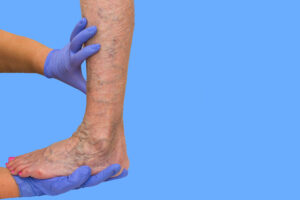Warning Signs of a Venous Insufficiency
 How much do you know about chronic venous insufficiency (CVI)? A condition that affects about 40 percent of adults, with an estimated 150,000 new cases diagnosed each year, it is most often found in women in their forties. While women are at highest risk, men can also develop venous insufficiency. It’s a problem that occurs when the valves in the blood vessels in your legs malfunction, causing blood to pool in the vessels instead of moving to the heart. When one valve doesn’t work properly, the pressure from the accumulated blood between the valves causes other valves to malfunction as well, making it a progressive condition. Left untreated, it can lead to problems like deep vein thrombosis, a condition that can lead to a life-threatening pulmonary embolism, and venous stasis ulcers, which can become debilitating. Like many medical conditions, it’s best treated early on, so it’s important to know the warning signs of venous insufficiency.
How much do you know about chronic venous insufficiency (CVI)? A condition that affects about 40 percent of adults, with an estimated 150,000 new cases diagnosed each year, it is most often found in women in their forties. While women are at highest risk, men can also develop venous insufficiency. It’s a problem that occurs when the valves in the blood vessels in your legs malfunction, causing blood to pool in the vessels instead of moving to the heart. When one valve doesn’t work properly, the pressure from the accumulated blood between the valves causes other valves to malfunction as well, making it a progressive condition. Left untreated, it can lead to problems like deep vein thrombosis, a condition that can lead to a life-threatening pulmonary embolism, and venous stasis ulcers, which can become debilitating. Like many medical conditions, it’s best treated early on, so it’s important to know the warning signs of venous insufficiency.
- One of the most common venous insufficiency symptoms is the presence of varicose veins. Even if your varicose veins are not causing you pain or discomfort, it’s best to seek medical attention, because they are a sign of venous hypertension and CVI. People with varicose veins are three times more likely to develop deep vein thrombosis than other people.
- Leg pain can be a symptom of venous insufficiency. If you notice that your legs ache when you stand still for an extended time period, but you find relief when you elevate them, it could be CVI. You might also experience tingling, burning, tightness, itching, or a heaviness in your legs. Don’t brush off these symptoms, because when you treat it early, venous insufficiency has less opportunity to cause dangerous medical conditions.
- If your lower legs swell, you may need venous insufficiency treatment. The pressure in your veins can cause edema, a type of swelling that often increases during the day and leaves an indentation if you press your skin.
- Don’t ignore changes to your skin. If the pressure in your leg veins is high, the veins will dilate, causing red blood cells to leave the veins and break down. This can create dark brown discoloration on the skin of your legs. You might also experience dermatitis, eczema, or a leathery appearance to your skin. All of these are signs of chronic venous insufficiency and the inflammation it causes.
You’re at higher risk of CVI if you’re obese, you tend to sit or stand for long periods of time, you don’t get enough exercise, or you smoke. A family history of CVI also puts you at risk of developing this condition. Fortunately, there are minimally invasive treatments for venous insufficiency. Endovenous laser ablation (EVLA) uses a catheter to close damaged veins, for example, and sclerotherapy treats them with the injection of a substance that closes them so that the blood can be rerouted to healthier vessels.
If you’re seeking varicose veins treatment or help with other vein issues, trust the board-certified physicians at the Arizona Vein & Laser Institute. Using the most advanced technology, the vascular and cardiovascular surgeons at the Arizona Vein & Laser Institute provide care for all types of venous diseases. With over 40 years of experience, our team of experienced physicians can devise the right treatment plan to address your venous disease problems. For more information contact us through our website.
